GMC ENVOY 1998 Owners Manual
Manufacturer: GMC, Model Year: 1998, Model line: ENVOY, Model: GMC ENVOY 1998Pages: 386, PDF Size: 20.33 MB
Page 231 of 386

Engine Fan Noise
This vehicle has a clutched engine cooling fan. When the
clutch is engaged, the fan spins faster to provide more air
to cool the engine. In most everyday driving conditions,
the clutch is
not engaged. This improves fuel economy and
reduces
fan noise. Under heavy vehicle loading, trailer
towing and/or high outside temperatures, the fan speed
increases when the clutch engages.
So you may hear an
increase in fan noise. This is normal and should not be
mistaken
as the transmission slipping or making extra
shifts. It is merely the cooling system functioning properly.
The fan will slow down when additional cooling is not
required and the clutch disengages.
You may
also hear this fan noise when you start the
engine. It will go away
as the fan clutch disengages.
If a Tire Goes Flat
It’s unusual for a tire to “blow out” while you’re driving,
especially if you maintain your tires properly.
If air goes
out of
a tire, it’s much more likely to leak out slowly.
But
if you should ever have a “blowout,” here are a few
tips about what to expect and what to do:
If
a front tire fails, the flat tire will create a drag that
pulls the vehicle toward that side.
Take your foot off the
accelerator pedal and grip
the steering wheel firmly.
Steer to maintain lane position, and then gently brake to
a stop well out of the traffic lane.
A rear blowout, particularly on a curve, acts much like a
skid and may require the same correction you’d use in a
skid. In any rear blowout, remove your foot from the
accelerator pedal. Get the vehicle under control by
steering the
way you want the vehicle to go. It may be
very bumpy and noisy, but you can
still steer. Gently
brake to
a stop -- well off the road if possible.
If a tire goes flat, the next part shows how to use your
iacking equipment to change
a flat tire safely. u Y a. c
5-20
ProCarManuals.com
Page 232 of 386

Changing a Flat Tire
If a tire goes flat, avoid further tire and wheel damage
by driving slowly to a level place. Turn on
your hazard
warning flashers.
A CAUTION:
I
Changing a tire can cause an injury. The vdcle
can slip
off the jack and roll over you or other
people. You and they could be badly injured.
Find a level place to change your tire. To help
prevent the vehicle from moving:
1. Set the parking brake firmly.
2. Put the shift lever in PARK (P).
3. lbrn off the engine.
4. Put the wheel blocks at the front and
rear of the tire farthest away from the
one being changed. That would be the
tire on the other side of the vehicle,
at
the opposite end.
The following steps will tell you how to use the jack and
change a tire.
5-21
ProCarManuals.com
Page 233 of 386
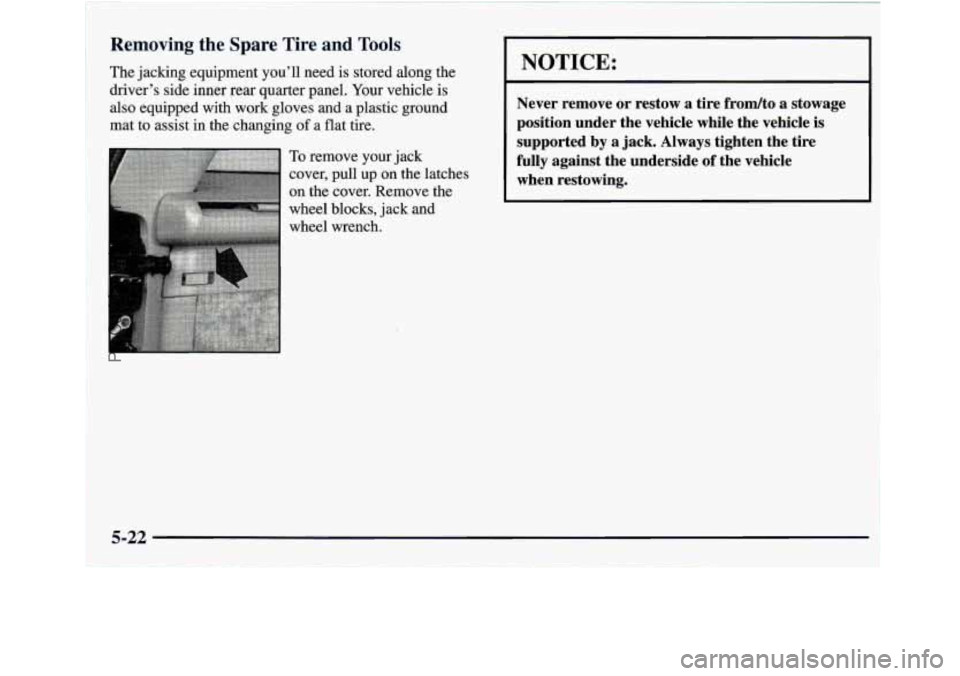
Removing the Spare Tire and Tools
The jacking equipment you’ll need is stored along the
driver’s side inner rear quarter panel. Your vehicle is
also equipped with work gloves and a plastic ground
mat to assist in the changing
of a flat tire.
To remove your jack
cover, pull up on the latches
on the cover. Remove the
wheel blocks, jack and
wheel wrench.
NOTICE:
Never remove or restow a tire frodto a stowage
position under the vehicle while the vehicle is
supported by a jack. Always tighten the tire
fully against the underside of the vehicle
when restowing.
5-22
ProCarManuals.com
Page 234 of 386
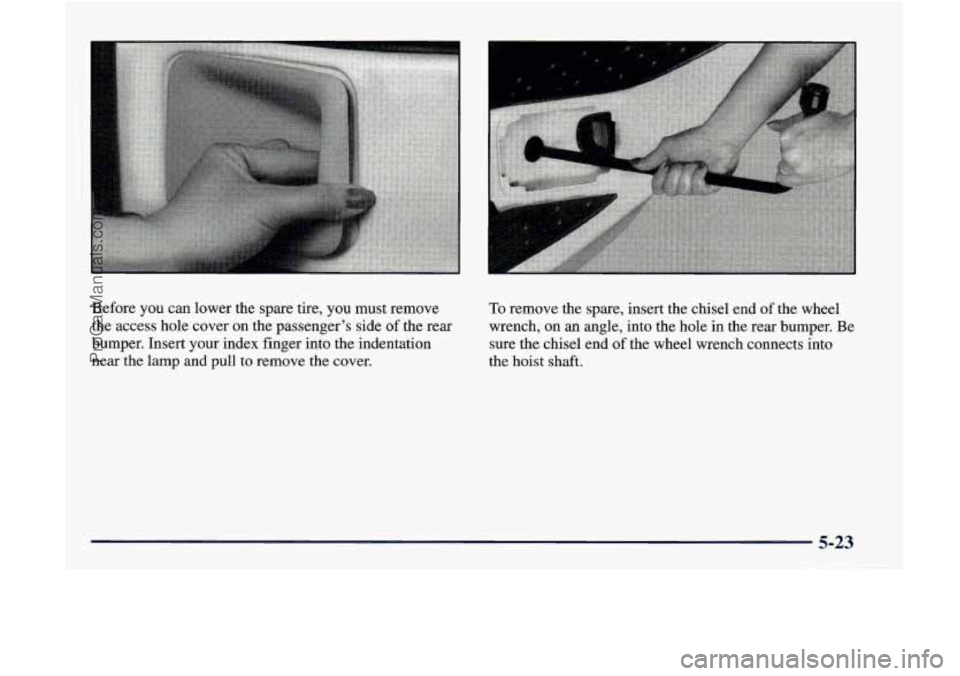
Before you can lower the spare tire, you must remove
the access hole cover on the passenger’s side
of the rear
bumper. Insert your index finger into the indentation
near the lamp and pull to remove the cover.
To remove the spare, insert the chisel end of the wheel
wrench, on an angle, into the hole in the rear bumper. Be
sure the chisel end of the wheel wrench connects into
the hoist shaft.
5-23
--
ProCarManuals.com
Page 235 of 386
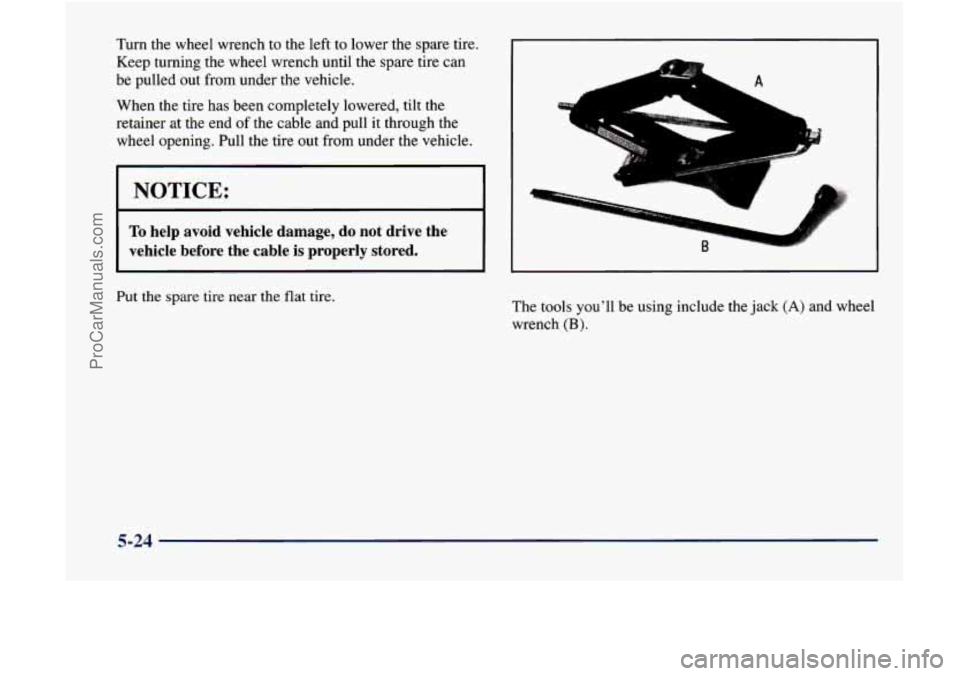
Turn the wheel wrench to the left to lower the spare tire.
Keep turning the wheel wrench until
the spare tire can
be pulled out from under the vehicle.
When the tire has
been completely lowered, tilt the
retainer at the end of the cable and pull it through the
wheel opening. Pull the tire out from under the vehicle.
NOTICE:
To help avoid vehicle damage, do not drive the
vehicle before the cable
is properly stored.
P the mare tire near the flat tire.
The tools you'll be using include the jack (A) and wheel
wrench
(B).
5 -24
ProCarManuals.com
Page 236 of 386
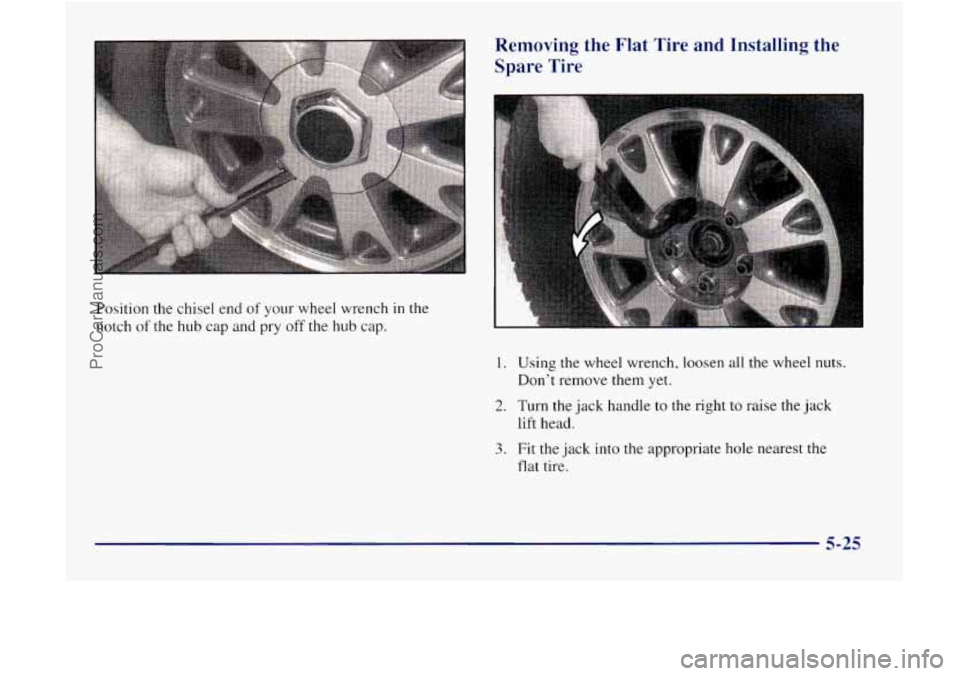
Position the chisel end of your wheel wrench in the
notch
of the hub cap and pry off the hub cap.
Removing the Flat Tire and Installing the
Spare Tire
1. Using the wheel wrench, loosen all the wheel nuts.
Don’t remove them yet.
2. Turn the jack handle to the right to raise the jack
lift head.
3. Fit the jack into the appropriate hole nearest the
flat tire.
5-25
ProCarManuals.com
Page 237 of 386
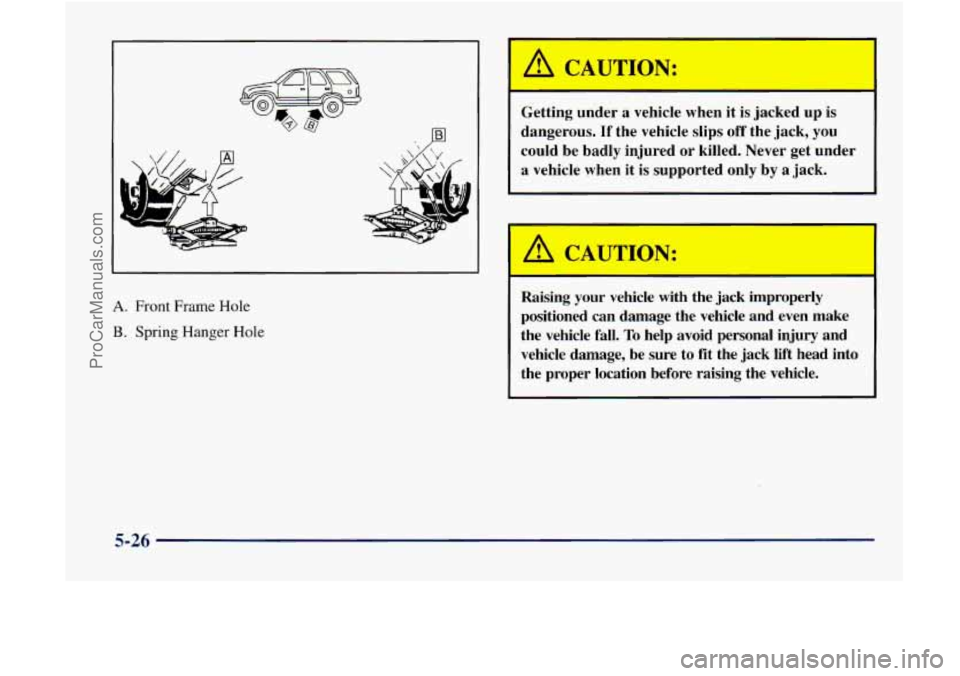
A. Front Frame Hole
B. Spring Hanger Hole
A CAUTION:
Getting under a vehicle when it is jacked up is
dangerous.
If the vehicle slips off the jack, you
could be badly injured or killed. Never get under
a vehicle when it is supported only by a jack.
I
A CAUTION:
Raising your vehicle with the jack improF,,,ly
positioned can damage the vehicle and even make
the vehicle fall.
To help avoid personal injury and
vehicle damage, be sure to fit the jack lift head into
the proper location before raising the vehicle.
I
5-26
ProCarManuals.com
Page 238 of 386
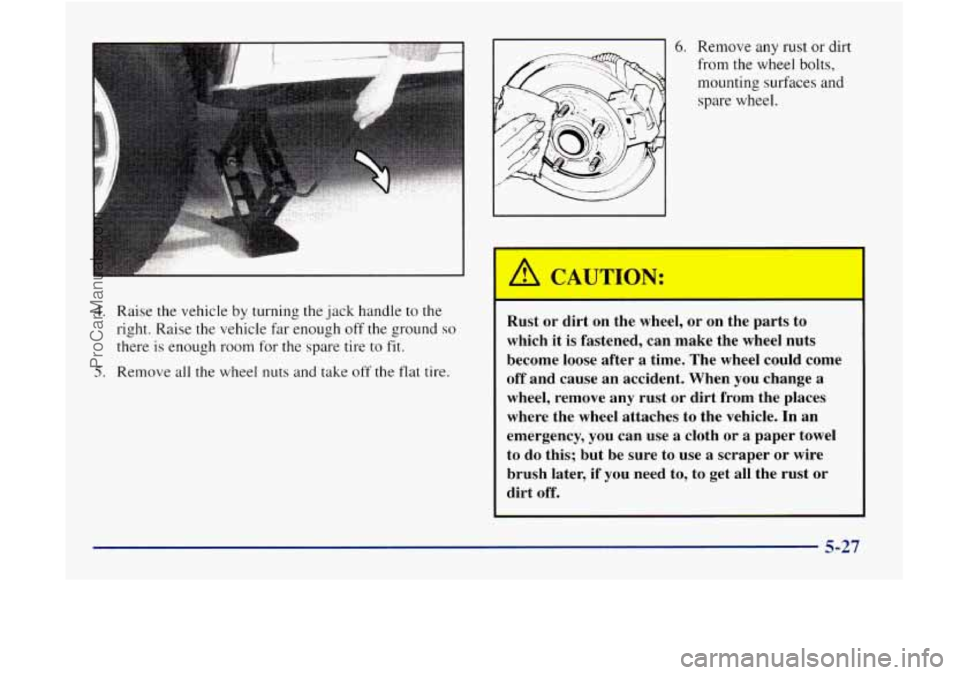
I
4. Raise the vehicle by turning the jack handle to the
right. Raise the vehicle
far enough off the ground so
there is enough room for the spare tire to fit.
5. Remove all the wheel nuts and take off the flat tire.
6. Remove any rust or dirt
from the wheel bolts,
mounting surfaces and
spare wheel.
Rust or dirt on the wheel, or on the parts to
which it is fastened, can make the wheel nuts
become loose after a time. The wheel could come
off and cause an accident. When you change
a
wheel, remove any rust or dirt from the places
where the wheel attaches to the vehicle. In an
emergency, you can use a cloth
or a paper towel
to do this; but be sure to use
a scraper or wire
brush later, if you need to, to get all the rust or
dirt
off.
I
5-27
ProCarManuals.com
Page 239 of 386
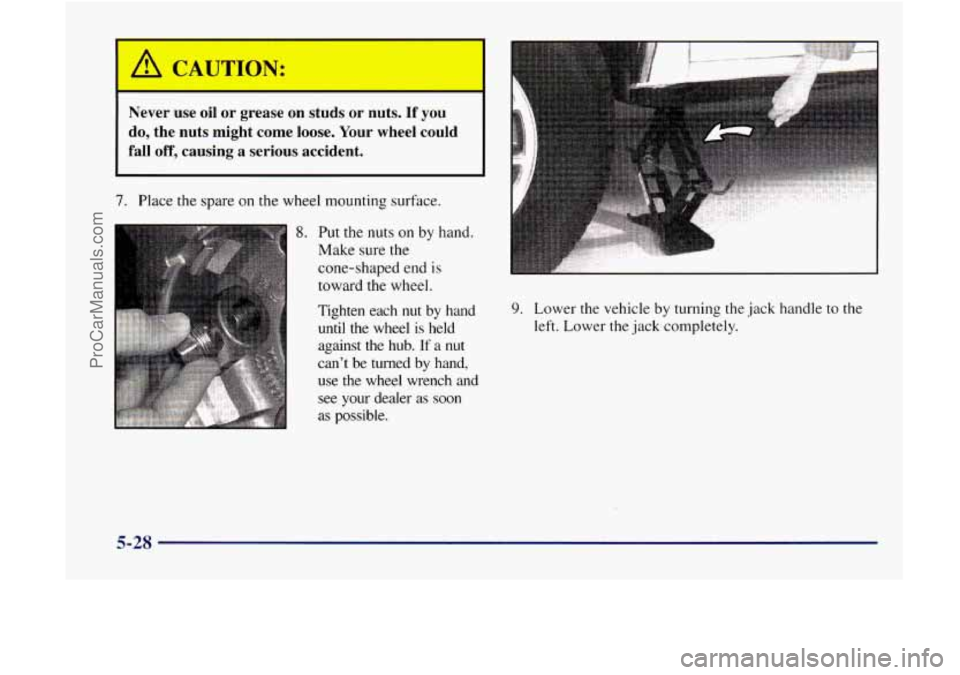
/I CAUTION:
Never use oil or grease on studs or nuts. If you
do, the nuts might come loose. Your wheel could
fall off, causing a serious accident.
7. Place the spare on the wheel mounting surface.
8. Put the nuts on by hand.
Make sure the
cone-shaped end is
toward the wheel.
Tighten each
nut by hand
until the wheel is held against the hub.
If a nut
can’t be turned by hand,
use the wheel wrench and
see your dealer as soon
as possible.
9. Lower the vehicle by turning the jack handle to the
left. Lower the jack completely.
5-28
ProCarManuals.com
Page 240 of 386
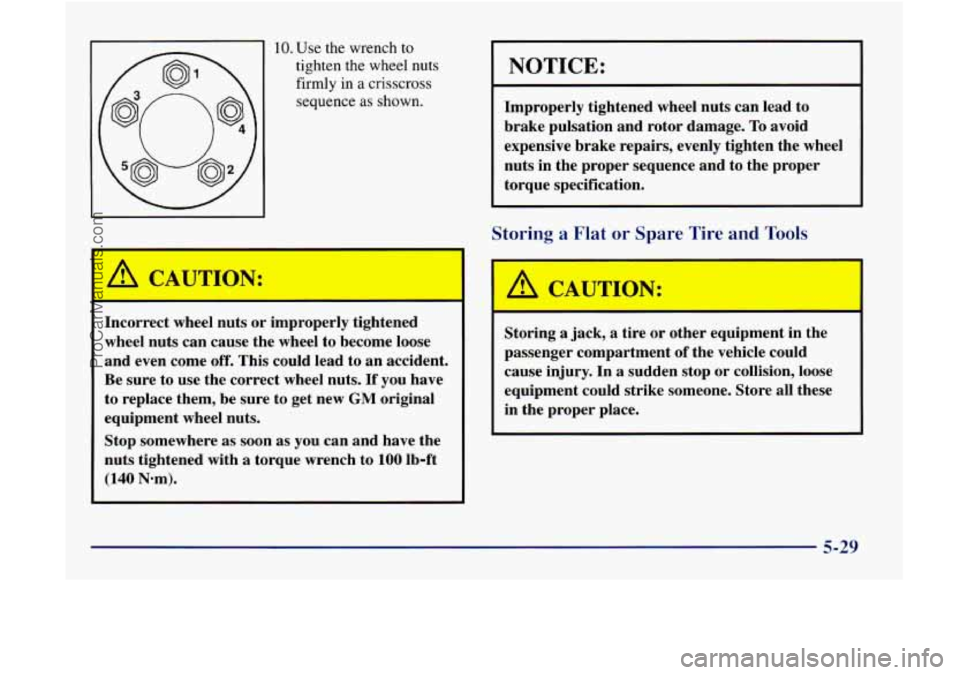
10. Use the wrench to
tighten the wheel nuts
firmly in
a crisscross
sequence
as shown.
NOTICE:
Improperly tightened wheel nuts can lead to
brake pulsation and rotor damage.
To avoid
expensive brake repairs, evenly tighten the wheel
nuts in the proper sequence and to the proper
torque specification.
Storing a Flat or Spare Tire and Tools
A CAUTION:
Incorrect wheel nuts or improperly tightened
wheel nuts can cause the wheel to become loose
and even come
off. This could lead to an accident.
Be sure to use the correct wheel nuts.
If you have
to replace them, be sure to get new
GM original
equipment wheel nuts.
Stop somewhere as soon as
you can and have the
nuts tightened with a torque wrench to
100 lb-ft
(140 Nom). Storing
a jack, a tire or other equipment in the
passenger compartment
of the vehicle could
cause injury.
In a sudden stop or collision, loose
equipment could strike someone. Store all these
in the proper place.
5-29
ProCarManuals.com